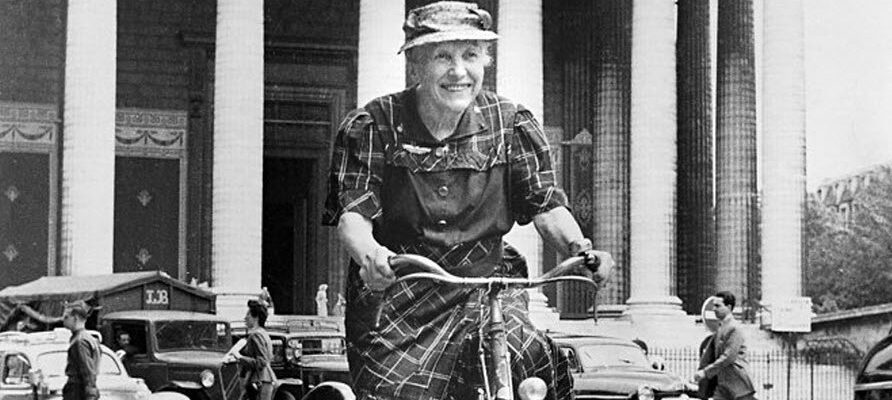Colette, free writer
Long forgotten, Colette is one of the greatest figures in 20th century literature. We owe him around sixty books, from “Blé en herbe” to “Chéri”. But Colette has also tried her hand at music hall, advertising, or even journalism. His claimed bisexuality takes an important place in his work. This is also one of the main themes of the book that revealed her to the general public: the first “Claudine”, a series of novels that will become a real fashion phenomenon. It was her husband Willy, already an author himself, who found her manuscript and discovered its incredible potential. It is also him whose name will appear on the cover. The success of the book is such that Willy launches into derivative products. But Colette intends to reclaim her work and regain her freedom.
>> Listen to the episode devoted to Colette’s youth
Marie Bonaparte, pioneer in sexology and psychoanalysis
The last descendant of Napoleon Bonaparte, Marie Bonaparte owes her notoriety to her work in sexology. Cut off from the world until her adolescence, then married at the age of 16 to a homosexual prince, Marie Bonaparte is inhabited by a big question: that of female pleasure. She is the first to establish a link between the anatomy of women and the absence of orgasm during sexual intercourse and to conduct a concrete study in this direction. But at a time when sexology is a medical field in which only men express themselves, it is not easy to make your voice heard. Marie Bonaparte is also known for her friendship with Sigmund Freud, for whom she became the French translator. It is largely to her that Freud owes the introduction of his methods in France.
>> Listen to the episode dedicated to work of Marie Bonaparte
Frida Kahlo, painter of pain
The most famous Mexican painter in the world still today, Frida Kahlo has left her mark in history with her poignant paintings. However, originally, she had not planned to become an artist. Following a tragic transport accident that almost killed her, Frida Kahlo sees her body turn into a prison. If she miraculously survived the shock, her right leg will be atrophied for life. So, during her convalescence, Frida Kahlo began to paint, and layered her physical and moral suffering on her canvases. She frequented communist circles and there met the painter Diego Riviera, who became her husband a year later. Together, the two artists travel to the United States. But unlike her husband, whose works are successful, Frida Kahlo’s art is considered too “gynecological”…
>> Listen to the episode dedicated to life and the work of Frida Kahlo
Marie Marvingt, the most decorated sportswoman in France
With 34 medals in a multitude of different sports, Marie Marvingt was a great French athlete in the 1910s. It is said that she would have been able to swim several kilometers from the age of 4. What is certain is that her father, a sports enthusiast seeing his daughter’s exceptional dispositions, introduced her very early to all kinds of physical activities at the time reserved for boys. Growing up, Marie Marvingt chained records. If she is best known for having been the first woman to participate in the Tour de France, she has many other sporting exploits to her credit. She was the first French woman to swim 12km across Paris following the course of the Seine. She was also considered a rock climbing pioneer, a ski champion, as well as a great aviator, especially during the First World War.
>> Listen to the episode dedicated to sporting achievements of Marie Marvingt
Find “At the heart of history” on: http://www.europe1.fr/emissions/au-coeur-de-l-histoire
Find us on :
| Our website: http://www.europe1.fr
| Facebook: https://www.facebook.com/Europe1
| Twitter: https://twitter.com/europe1″ />
Nellie Bly, the first investigative journalist
Nellie Bly was doing undercover social investigations at a time when female journalists could only hope to write for fashion and culture. It all started in 1875, when she came across an article titled “What Girls Are Good For” in the Pittsburgh Dispatch that urged young women to stay in their role as housekeepers rather than go to school or seek a work. Revolted, she writes to the editor, but her letter is so skilfully twisted that it allows her to obtain a position in this newspaper. To protect her identity, she then takes the name of Nellie Bly. For her reports, Nellie Bly did not hesitate to dress up and play a character, sometimes posing as a worker, sometimes as a psychiatric patient in an asylum, with the aim of denouncing from the inside the conditions terrible life in these establishments.
>> Listen to the episode dedicated to Nellie Bly Investigations
Find “At the heart of history” on: http://www.europe1.fr/emissions/au-coeur-de-l-histoire
Find us on :
| Our website: http://www.europe1.fr
| Facebook: https://www.facebook.com/Europe1
| Twitter: https://twitter.com/europe1″ />
To discover the life and work of other historical figures, listen to “At the heart of history”, a podcast produced by Europe 1 Studio available on all listening platforms.
